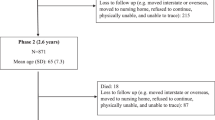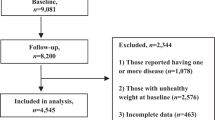Abstract
OBJECTIVE: To examine associations between rate of eating and macronutrient and dietary fiber intake, and body mass index (BMI).
DESIGN: Cross-sectional study.
SUBJECTS: A total of 1695 18-y-old female Japanese dietetic students.
MEASUREMENTS: Macronutrient intake (protein, carbohydrate, and fat) and dietary fiber intake were assessed over a 1-month period with a validated, self-administered, diet history questionnaire. Body height and weight and rate of eating (according to five categories) were self-reported.
RESULTS: Among the nutrients examined, only dietary fiber intake weakly, but significantly, and negatively correlated with BMI in a multiple regression analysis. The rate of eating showed a significant and positive correlation with BMI. The mean BMI was higher by 2.2, 1.5, 1.0, and 0.5 kg/m2 in the ‘very fast’, ‘relatively fast’, ‘medium’, and ‘relatively slow’ groups, respectively, compared with the ‘very slow’ rate of eating group. This correlation remained evident after adjustment for nutrient intake.
CONCLUSIONS: Rate of eating showed a significant and positive correlation with BMI, whereas only dietary fiber intake showed a weak correlation with BMI.
This is a preview of subscription content, access via your institution
Access options
Subscribe to this journal
Receive 12 print issues and online access
$259.00 per year
only $21.58 per issue
Buy this article
- Purchase on Springer Link
- Instant access to full article PDF
Prices may be subject to local taxes which are calculated during checkout
Similar content being viewed by others
References
Hill SW, McCutcheon NB . Contributions of obesity, gender, hunger, food preference, and body size, bite speed, and rate of eating. Appetite 1984; 5: 73–83.
Spiegel TA, Wadden TA, Foster GD . Objective measurement of eating rate during behavioral treatment of obesity. Behav Ther 1991; 22: 61–67.
Barkeling B, Ekman S, Rossner S . Eating behaviour in obese and normal weight 11-year-old children. Int J Obes Relat Metab Disord 1992; 16: 355–360.
Gerace TA, George VA . Predictors of weight increases over 7 years in fire fighters and paramedics. Prev Med 1996; 25: 593–600.
Ortega RM, Redondo MR, Lopez-Sobaler AM, Quintas ME, Zamora MJ, Andres P, Encinas-Sotillos A . Associations between obesity, breakfast-time food habits and intake of energy and nutrients in a group of elderly Madrid residents. J Am Coll Nutr 1996; 15: 65–72.
Lissner L, Heitmann BL . Dietary fat and obesity: evidence from epidemiology. Eur J Clin Nutr 1995; 49: 79–90.
Seidell JC . Dietary fat and obesity: an epidemiologic perspective. Am J Clin Nutr 1998; 67(Suppl): 546S–550S.
Willett WC . Is dietary fat a major determinant of body fat? Am J Clin Nutr 1998; 67(Suppl): 556S–562S.
Na HB, Kim SR . A study of energy intake and body fat percent of college students in Seoul. J Commun Nutr 2000; 2: 105–109.
Stookey JD . Energy density, energy intake and weight status in a large free-living sample of Chinese adults: exploring the underlying roles of fat, protein, carbohydrate, fiber and water intakes. Eur J Clin Nutr 2001; 55: 349–359.
Trichopoulou A, Gnardellis C, Benetou P, Bamita C, Trichopoulos D . Lipid, protein and carbohydrate intake in relation to body mass index. Eur J Clin Nutr 2002; 56: 37–43.
Stevens J . Does dietary fiber affect food intake and body weight? J Am Diet Assoc 1988; 88: 939–945.
Ludwig DS, Pereira MA, Kroenke CH, Hilner JE, Van Horn L, Slattery ML, Jacobs Jr DR . Dietary fiber, weight gain, and cardiovascular disease risk factors in young adults. JAMA 1999; 282: 1539–1546.
Duncan KH, Bacon JA, Weinsier RL . The effects of high and low energy diets on satiety, energy intake, and eating time of obese and nonobese subjects. Am J Clin Nutr 1993; 57: 763–767.
Drewnowski A . Energy, density, palatability, and satiety: implications for weight control. Nutr Rev 1998; 56: 247–253.
Sasaki S, Tsuji T, Katagiri A, Shimoda T for the Diets of the Fresh Students in Dietetic Courses Study Group. Association between the numbers of food items bought in convenience stores and nutrient and food-group intakes—a survey of first-year female college students taking dietetic courses. J Jon Soc Nutr Sci 2000; 53: 215–226 (in Japanese with English abstract).
Sasaki S, Yanagibori R, Amano K . Self-administered diet history questionnaire developed for health education: a relative validation of the test-version by comparison with 3-day diet record in women. J Epidemiol 1998; 8: 203–215.
Sasaki S, Ushio F, Amano K, Morihara M, Todoriki T, Uehara Y, Toyooka T . Serum biomarker-based validation of a self-administered diet history questionnaire for Japanese subjects. J Nutr Sci Vitaminol 2000; 46: 285–296.
Ministry of Health and welfare. Recommended dietary allowance for Japanese: dietary reference intakes, 6th revised edn. Ministry of Health and Welfare; 1999 (in Japanese).
Block G, Woods M, Potosky A, Clifford C . Validation of a self-administered diet history questionnaire using multiple diet records. J Clin Epidemiol 1990; 43: 1327–1335.
Rimm EB, Giovannucci EL, Stampfer MJ, Colditz GA, Litin LB, Willett WC . Reproducibility and validity of an expanded self-administered semiquantitative food frequency questionnaire among male health professionals. Am J Epidemiol 1992; 135: 1114–1126.
Willett W, Stampfer MJ . Total energy intake: implications for epidemiologic analysis. Am J Epidemiol 1986; 124: 17–27.
Braam LA, Ocke MC, Bueno-de-Mesquita HB, Seidell JC . Determinants of obesity-related underreporting of energy intake. Am J Epidemiol 1998; 147: 1081–1086.
Trabulsi J, Schoeller DA . Evaluation of dietary assessment instru-ments against doubly labeled water, a biomarker of habitual energy intake. Am J Physiol Endocrinol Metab 2001; 281: E891–E899.
Ferrari P, Slimani N, Ciampi A, Trichopoulou A, Naska A, Lauria C, Veglia F, Bueno-de-Mesquita HB, Ocke MC, Brustad M, Braaten T, Jose Tormo M, Amiano P, Mattisson I, Johansson G, Welch A, Davey G, Overvad K, Tjonneland A, Clavel-Chapelon F, Thiebaut A, Linseisen J, Boeing H, Hemon B, Riboli E . Evaluation of under- and overreporting of energy intake in the 24-hour diet recalls in the European Prospective Investigation into Cancer and Nutrition (EPIC). Public Health Nutr 2002; 5: 1329–1345.
Miyagi S . Relationship between obesity level of female students and their dietary habits, health and body perception. Jpn J Nutr 1998; 56: 33–45 (in Japanese with English abstract).
Goodman E, Hinden BR, Khandelwal S . Accuracy of teen and parental reports of obesity and body mass index. Pediatrics 2000; 106: 52–58.
Kuczmarski MF, Kuczmarski RJ, Najjar M . Effects of age on validity of self-reported height, weight, and body mass index: findings from the third national health and nutrition examination survey, 1988–1994. J Am Diet Assoc 2001; 101: 28–34.
Author information
Authors and Affiliations
Corresponding author
Rights and permissions
About this article
Cite this article
Sasaki, S., Katagiri, A., Tsuji, T. et al. Self-reported rate of eating correlates with body mass index in 18-y-old Japanese women. Int J Obes 27, 1405–1410 (2003). https://doi.org/10.1038/sj.ijo.0802425
Received:
Revised:
Accepted:
Published:
Issue Date:
DOI: https://doi.org/10.1038/sj.ijo.0802425
Keywords
This article is cited by
-
Relationships of rapid eating with visceral and subcutaneous fat mass and plasma adiponectin concentration
Scientific Reports (2023)
-
The relationship between meal regularity with Irritable Bowel Syndrome (IBS) in adults
European Journal of Clinical Nutrition (2022)
-
Observational Study on Unhealthy Eating Behavior and the Effect of Sodium-Glucose Cotransporter 2 Inhibitors: The Luseogliflozin Ehime Diabetes Study
Diabetes Therapy (2022)
-
The inverse association between unhealthy eating habit and mucosal healing among patients with ulcerative colitis
BMC Gastroenterology (2021)
-
Correlation between estimated plasma remnant-like particle cholesterol and vegetable fat intake in Uku town, Japan
Environmental Health and Preventive Medicine (2021)



